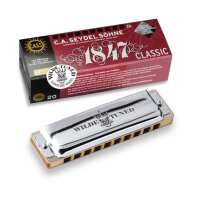
A brilliant model with STAINLESS STEEL reeds from The Worlds Oldest Harmonica Company Seydel. Seydel have been hand making harmonicas in Klingenthale, Germany since the year 1847 and this is the celebration ‘Original Seydel 1847’ Blues Harmonica. 1847 CLASSIC: Special Tuning: Wilde Rock Tuning Will Wilde Rock Harmonica Tuning SEYDEL Endorser Will Wilde is the inventor of this Special Tuning which is very well suited for "tougher" musical styles like Hardrock or Blues-Rock. Read here how this tuning was invented and why Will uses it regularely since a few years in his shows: "I designed the Wilde tuning specifically for playing hard rock and blues-rock on the harmonica. As much as I love the standard Richter tuning, I have always found it frustrating when it comes to playing “rock guitar” style licks, particularly in the upper octave. The Wilde tuning addresses all of the problems I had with Richter, whilst still retaining the bluesy feel of classic second position harmonica that we all know and love. Whereas Richter tuning was primarily designed for playing major chords and the major scale in first position, Wilde tuning is specifically designed for playing second position minor pentatonic and blues scale licks, throughout all three octaves. I have always preferred the sound of draw notes and draw bends to blow notes and blow bends, as you can get more expression and a better tone & vibrato from them. So, on the Wilde tuning ALL of the draw notes bend (from holes one to ten) and your root note lands on a draw in all three octaves. I think that the Wilde tuning is the configuration that every aspiring rock harp player has been waiting for." Details about Wilde Rock special tuning: Holes one to five are exactly the same as standard tuning. Holes six, seven and eight are the same as holes two, three and four (just an octave higher). Hole nine is the same as hole two (two octaves higher) and the reeds in hole ten have been switched around (so that the ten blow bend is now a draw bend). This makes fast minor pentatonic/blues scale runs much easier and means you no longer need to overblow/overdraw to get the flat third and flat five in the upper octave as they are now available as simple draw bends. • Full and loud, overtone-rich sound and extremely fast tone-response due to stainless steel reeds • Very long durability and even with heavy duty playing - stainless steel reeds and stainless steel rivets • Less air-loss due to fine-cut reedplates - optimized flatness and extremely small tolerances between reed and reedplate • Beard- and lip-friendly - coverplates with rounded edges without any cuts at the mouthpiece and ergonomic built hole-openings and rounded dividers • The overtone-rich sound can spread out undampened - covers made of extra strong stainless steel sheet (0.4mm), opened wide at the back and crimped and therefore a good stability and rounded edges • moisture-proof, swelling-free maple-comb, sealed with multiple layers of food-safe finish The 1847, a harmonica, that impresses from innovation but nevertheless fits all traditional demands - a master's instrument for maximum ambitions. The 1847 is the result of more than 170-years of experience in manufacturing high-quality harmonicas. Also in a set with the most important keys.
Visit Product Page
